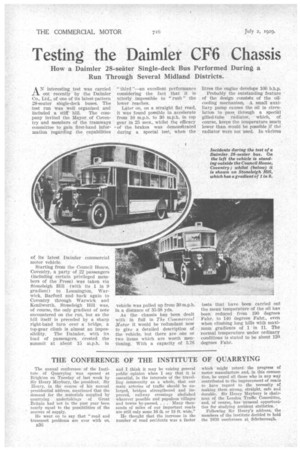Testing the Daimler CF6 Chassis
Page 62

If you've noticed an error in this article please click here to report it so we can fix it.
How a Daimler 28-seater Single-deck Bus Performed During a Run Through Several Midland Districts.
AN interesting test was carried out recently by the Daimler Co., Ltd., of one of its latest-pattern 28-seater single-deck buses. The test run was well organized and included a stiff hill. The company invited the Mayor of Coventry and members of the tramways committee to gain first-hand information regarding the capabilities
of its latest Daimler commercial motor vehicle.
Starting from the Council House, Coventry, a party of 22 passengers (including certain privileged members of the Press) was taken via Stoneleigh Hill (with its 1 in 9 gradient) to Leamington, Warwick, Barford and back again to Coventry through Warwick and Kenilworth. Stoneleigh Hill was, of course, the only gradient of note encountered on the run, but as the hill itself is preceded by a sharp right-hand turn over a bridge, a top-gear climb is almost an impossibility. The Daimler, with its load of passengers, crested the summit at about 15 m.p.h. in "third "—an excellent performance considering the fact that it is utterly impossible to " rush " the lower reaches.
Later on, on a straight flat road, it was found possible to accelerate from 10 m.p.h. to 30 m.p.h. in top gear in 25 secs., whilst the efficacy of the brakes was demonstrated during a special test, when the vehicle was pulled up from 30 m.p.h. in a distance of 35-38 yds.
As the chassis has been dealt with in full in The Commercial Motor it would be redundant now to give a detailed description of the vehicle, but there are one or two items which are worth mentioning. With a capacity of 5.76
litres the engine develops 100 b.h.p.
Probably the outstanding feature of the design consists of the oilcooling mechanism. A small auxiliary pump causes the oil in circulation to pass. through a special gilled-tube radiator, which, of course, keeps the temperature much lower than would be possible if the radiator were not used. In various
tests that have been carried out the mean temperature of the oil has been reduced from 190 degrees Fahr. to 140 degrees Fahr., even when climbing long hills With maximum gradients of 1 in 11. The normal temperature under ordinary conditions is stated to be about 120 degrees Fahr.




















































































































